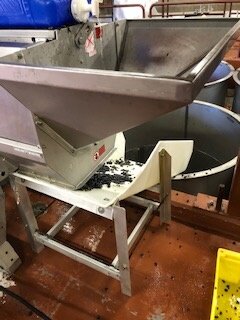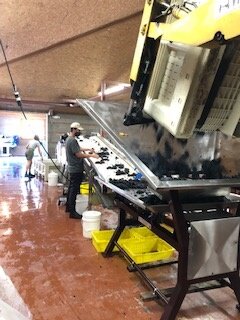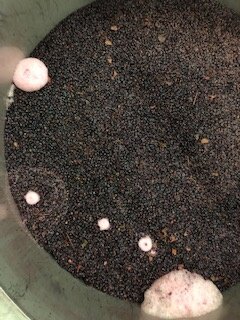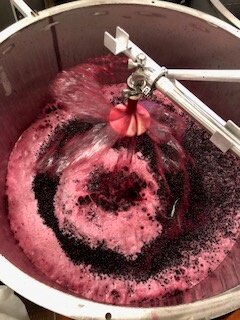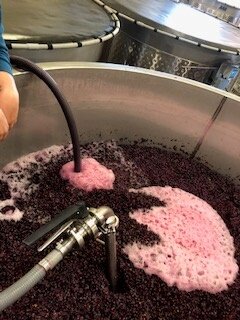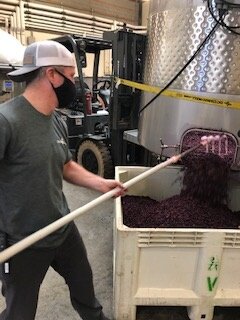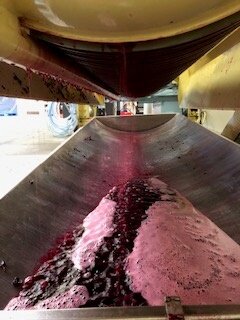A look at the 2021 Harvest
So what else is going on in the cellar now that (nearly) all of the fruit is indoors? Well get a load of this.
Chardonnay cave
The final load of white wine grapes (Pinot blanc from our Bryan Creek Vineyard) is in the press! Cave One is nearly full of Chardonnay merrily fermenting away. Extra room in the caves is starting to become non-existent, so some of our Chardonnay is fermenting on barrel racks in our warehouse. But having too much wine is not a bad problem to have.
And now moving over to red wines, here is the red crush set up:
Grapes get dumped from the picking bins into the hopper. The shaker table under the hopper…well…shakes, and meters fruit out onto the sorting table. You can also see intrepid intern John regretting his life choices after sorting through literally hundreds of tons of Pinot noir. At the end of the sorting table is the destemmer; you can see it better in the picture below. Fruit drops down from the sorting table into the destemmer, where the berries are removed from the rachis (stem). The berries take a ride down the slide and into the tank.
Once the Pinot noir is in tank we’ll let it sit for a few days in cold soak, and then start the fermentation. During fermentation the yeast will eat sugar and produce alcohol and carbon dioxide. The carbon dioxide will bubble up, lifting the skins to the top which form a “cap” on top of the fermenter; much of the liquid remains below. Look at this weird tank that really wants some cap management:
The CO2 is finding a way to get out in the form of little pink volcanoes. In order to make the fermenters healthy, happy, and providing us with the amount of extraction we want, once or twice a day we’ll mix in the cap to ensure it is participating in the fermentation activity; the type of “cap management” chosen, its frequency, and the timing of those actions is a stylistic choice . At Adelsheim, we do a LOT of pumpovers for our cap management sprinkled in with a few critical and timely punchdowns. In order to build yeast health early in fermentation we will do aerative pumpovers; yeast love oxygen when they’re in their growth phase and giving them some at an early stage helps them build and incorporate compounds that will help them survive the harsh alcoholic environment soon to come. Plus, look at how COOL THIS NEW PUMPOVER IRRIGATOR IS. So pretty! Matt, Shaun, and Zack did a LOT of planning and engineering in the off season to design the framework for this device and the results are even better than expected. Excellent work by all of them.
In the middle of fermentation we’ll do 1-2 punchdowns to help break some berries open and modulate our extraction. For the smaller tanks in New Ferm these are all done by hand. You can see how much higher the unpunched cap is to the picture of the drop off in the punched down section. The punchdown released a bunch of carbon dioxide trapped by the cap and the cap has fallen a bit. It’ll rise back up in no time as more CO2 is produced. Towards the end of fermentation we’ll also do some non-aerative pumpovers. This helps ensure relative homogeneity throughout the fermenter as the last of the sugar is converted to alcohol, without overly oxidizing the newly fermented wine. Much less splashy, as you can see.
Once the tanks are close to being “dry” with no sugar left we’ll start tasting them to decide when to press. We may also throw in a cheeky light punchdown or two at this stage to provide some structure, but this depends on how the wine tastes, vintage considerations, etc.
Lastly, for those of you still following along, here is the red press doing what it does best. Once the fermenters are dry we will drain off anything that comes out into a tank (this is the free run). Once the tank is drained some lucky soul will dig out all of the skins into bins; the must is still quite juicy at this stage as it has a lot if wine trapped in it. The bins are loaded into the press, we start slowly increasing the pressure to squeeze out the trapped wine, and generally just space out watching the mesmerizing fall of fresh wine into the tray. It smells INCREDIBLE.
We will make a press cut at some point, again depending on flavor and tannin, and that’s it! The wine is pressed! Next steps are racking and barreling down, but you’ll have to wait for that for a few more days…



